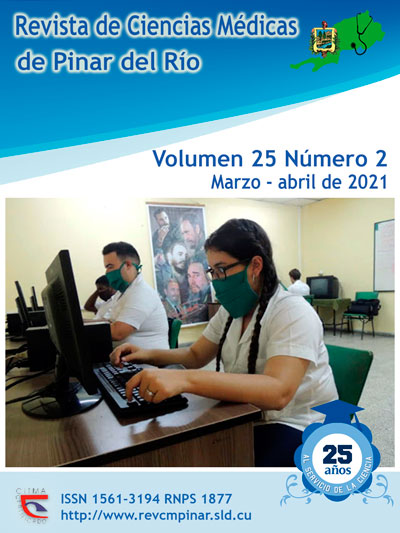Effectiveness of ozone therapy in the treatment of Sever's disease
Keywords:
CHILDREN, HOMEOPATHY/treatment, CLASSIFICATION, DRUG UTILIZATION, CALCANEUS, OSTEOCHONDROSIS, FOOT BONES.Abstract
Introduction: Sever's disease is a common cause of thalalgia in children.
Objective: to evaluate the effectiveness of the Ozone Therapy in the treatment of Sever's disease in children from 7-18 years old attended at Pepe Portilla Pediatric Provincial Teaching Hospital, Pinar del Rio province, during July 2017 to July 2018.
Methods: longitudinal and prospective descriptive research was conducted to 46 children, who attended Natural and Traditional Medicine service with relapsed of Sever's disease. Therapeutic ozone was applied to them through the rectal route, and by means of the OZOMED mini-equipment. Descriptive tools such as frequency tables and percentage calculation were used throughout the process.
Results: the age group from 7 to 12 years old was the most represented and male sex prevailed over the female, the calcaneus valgus was the most frequent foot deformity. High physical activity prevailed in the 73.9% of children and half of them were overweight or obese. By the fourth week of treatment, the total of cases were relieved, without relapses. No undesirable effects during the application of ozone therapy were observed.
Conclusions: ozone therapy is a useful therapeutic modality in the treatment of Sever's disease.
Downloads
References
1. Hernández García S, Martínez Couce I, Menéndez Fadraga L, Sosa Fernández A, Rodríguez Arencibia MA. Resultados del tratamiento homeopático de la enfermedad de Sever. Rev Ciencias Médicas [Internet]. 2016 Abr [citado 9/07/2019]; 20(2): 44-53. Disponible en: http://scielo.sld.cu/scielo.php?script=sci_arttext&pid=S1561-31942016000200009&lng=es
2. Reyes Cadena A. El niño con dolor de piernas. Acta pediatr. Méx [Internet]. 2016 [citado 9 Jul 2019]; 37(3):183-187. Disponible en: http://www.scielo.org.mx/pdf/apm/v37n3/2395-8235-apm-37-03-00183.pdf
3. Delgado Bustillo F. Enfermedad psicógena masiva a partir de un caso de enfermedad de Sever. Medisur [Internet]. 2018 Dic [citado 9/07/2019]; 16(6): 769-771. Disponible en: http://scielo.sld.cu/scielo.php?script=sci_arttext&pid=S1727-897X2018000600002&lng=es
4. Mariette Dautt Medina P, Vidal Ruiz CA, Iñiguez R, Amador Martínez A del C. Enfermedad de Sever o apofisitis del calcáneo. Una patología mal identificada. Revista Mexicana de Ortopedia Pediátrica. [Internet]. 2019 enero-diciembre [citado 06/04/2020]; 21(1-3): 18-21. Disponible en: https://www.medigraphic.com/pdfs/opediatria/op-2019/op191_3d.pdf
5. James AM, Williams CM, Luscombe M, Hunter R, Haines TP. Factors Associated with Pain Severity in Children with Calcaneal Apophysitis (Sever Disease). The Journal of Pediatrics [Internet]. 2015 Agu [cited 2015 dic 20]; 167(2):455-59. Available from: http://www.sciencedirect.com/science/article/pii/S0022347615004370
6. Espinosa Leal EA, Espinosa Hernández EA. Síndrome de talón doloroso, enfermedad de Sever: presentación clínica, hallazgos de imágenes y manejo del dolor en niños y jóvenes atletas. Rev Med de Cos Cen [Internet]. 2016 [citado 9/07/2019]; 73 (619).p.383-387. Disponible en: https://www.medigraphic.com/cgi-bin/new/resumen.cgi?IDARTICULO=67508
7. Vergara Amador Enrique, Erazo Acosta Lina M, Moreno Gómez Luz Ángela. Patrones radiológicos normales del calcáneo en niños. Rev Cubana Ortop Traumatol [Internet]. 2017 Jun [citado 06/04/2020]; 31(1): 1-11. Disponible en: http://scielo.sld.cu/scielo.php?script=sci_arttext&pid=S0864-215X2017000100001&lng=es
8. Enfermedad de Sever: alcance y tratamiento. [Internet]. 2018 [citado 06/04/2020 ]. Disponible en: https://cilefmedical.cl/2018/01/09/enfermedad-sever-alcance-tratamiento/
9. Saldaña García L. Aplicaciones de la Ozonoterapia en el campo de la medicina y la estomatología. Congreso Internacional de Estomatología. [Internet]. 2015 [citado 6/09/2019]. Disponible en: http://www.estomatologia2015.sld.cu/index.php/estomatologia/nov2015/paper/viewPaper/1185
10. Alvarado Güémez F, Batilde Lima Hernández L, Núñez Lima C, Mora de la Cruz G. Aplicación de microdosis de Ozono en pacientes portadores de dolor o daños neurológicos. Reporte de 67 casos. Revista Española de Ozonoterapia [Internet]. 2016 [citado 6/09/2018];6(1). Disponible en: http://www.revistaespañoladeOzonoterapia.es/index.php/reo/article/view/93
11. Alfaro Cristales SM. BRIO3 Infiltración biorreguladora con Ozono y manejo del dolor musculo esquelético. Revista Española de Ozonoterapia [Internet]. 2016 [citado 6/09/2018];6(1):63-70. Disponible en: http://www.revistaespañoladeOzonoterapia.es/index.php/reo/article/view/88
12. Hernández García SH. Opciones terapéuticas de medicina
bioenergética y natural en pediatría [Internet] España: Editorial Académica española; 2016.p.1-23.
13. de Armas Mestre J, Soria Pérez R, Porto Álvarez RF, Álvarez Núñez R, Fontes Almeida Y O. Evaluación del manejo de pacientes pediátrico con dolor en miembros inferiores. 2014-2017. Rev.Med.Electrón. [Internet]. 2019 Oct [citado 27/04/2020] ; 41( 5 ): 1152-1165.
Disponible en: http://scielo.sld.cu/scielo.php?script=sci_arttext&pid=S1684-18242019000501152&lng=es .
14. Sánchez Prida P, Sánchez Domínguez A, Martín Fernández O, Martín Gordoc V, Martín Moreno V. Valoración del dolor de tobillo: síndrome del impacto posterior del tobillo secundario a proceso de Stieda .Medicina de familia SEMERGEN. [Internet]; 2016[citado 06/04/2020 ].: 42 (8) 146-148 Disponible en: https://www.elsevier.es/es-revista-medicina-familia-semergen-40-articulo-valoracion-del-dolor-tobillo-sindrome-S1138359316001088
Downloads
Published
How to Cite
Issue
Section
License
Authors who have publications with this journal agree to the following terms: Authors will retain their copyrights and grant the journal the right of first publication of their work, which will be publication of their work, which will be simultaneously subject to the Creative Commons Attribution License (CC-BY-NC 4.0) that allows third parties to share the work as long as its author and first publication in this journal are indicated.
Authors may adopt other non-exclusive license agreements for distribution of the published version of the work (e.g.: deposit it in an institutional telematic archive or publish it in a volume). Likewise, and according to the recommendations of the Medical Sciences Editorial (ECIMED), authors must declare in each article their contribution according to the CRediT taxonomy (contributor roles). This taxonomy includes 14 roles, which can be used to represent the tasks typically performed by contributors in scientific academic production. It should be consulted in monograph) whenever initial publication in this journal is indicated. Authors are allowed and encouraged to disseminate their work through the Internet (e.g., in institutional telematic archives or on their web page) before and during the submission process, which may produce interesting exchanges and increase citations of the published work. (See The effect of open access). https://casrai.org/credit/



